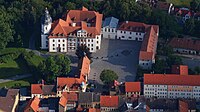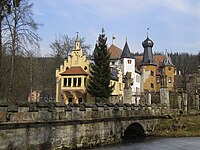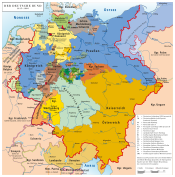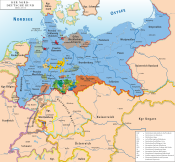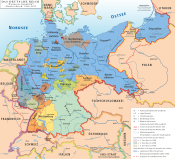Saxe-Altenburg
Duchy of Saxe-Altenburg (1602–1918) Herzogtum Sachsen-Altenburg Free State of Saxe-Altenburg (1918–1920) Freistaat Sachsen-Altenburg | |||||||||
|---|---|---|---|---|---|---|---|---|---|
| 1602–1672 1826–1920 | |||||||||
| Anthem: Heil unserm Herzog, heil (Hail to our Duke, hail!) | |||||||||
| Capital | Altenburg | ||||||||
| Government | Duchy (1602–1918) Republic (1918–1920) | ||||||||
| Duke | |||||||||
• 1603–1613 | Johann Philipp (first) | ||||||||
• 1908–1918 | Ernst II (last) | ||||||||
| History | |||||||||
• German Revolution | November 1918 | ||||||||
• Merger of Thuringia ‡ | 1920 | ||||||||
| |||||||||
* See Reuß all merged to form the Free State of Thuringia . | |||||||||
Saxe-Altenburg (German: Sachsen-Altenburg) was one of the Saxon duchies held by the Ernestine branch of the House of Wettin in present-day Thuringia.[1] It was one of the smallest of the German states with an area of 1323 square kilometers and a population of 207,000 (1905) of whom about one fifth resided in the capital, Altenburg. The territory of the duchy consisted of two non-contiguous territories separated by land belonging to the Principality of Reuss-Gera. Its economy was based on agriculture, forestry, and small industry. The state had a constitutional monarchical form of government with a parliament composed of thirty members chosen by male taxpayers over 25 years of age.
Territory
Saxe-Altenburg had an area of 1,323 km2 (510 sq. mi.) and a population of 207,000 in 1905. Its capital was Altenburg.
The duchy consisted of two separate areas: the Ostkreis, containing the cities of Altenburg, Schmölln, Gößnitz, Lucka und Meuselwitz (including the exclave of Mumsdorf), Roschütz, Hilbersdorf, Neukirchen by Waldenburg and Rußdorf by Chemnitz; and the Westkreis, which contained the cities of Eisenberg, Kahla, Orlamünde und Roda (including the exclave of Ammelstädt). The Ostkreis roughly corresponds to the modern Altenburger Land district of Thuringia, plus the area around Ronneburg in Greiz. The Westkreis is now mostly in Saale-Holzland district, with small portions in neighbouring districts. The duchy contained the Pleiße and Saale rivers.
History

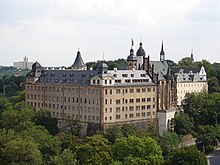
The duchy had its origins in the medieval Burgraviate of
When Johann Wilhelm's son and successor
Saxe-Altenburg thereafter remained part of
Dukes of Saxe-Altenburg
Elder line
- Johann Philipp, Duke of Saxe-Altenburg (1603–1639)
- Friedrich Wilhelm II, Duke of Saxe-Altenburg (1639–1669)
- Friedrich Wilhelm III, Duke of Saxe-Altenburg (1669–1672)
Line extinct, inherited by Saxe-Gotha, thereupon Saxe-Gotha-Altenburg
Junior line
- Frederick, Duke of Saxe-Altenburg (1826–1834) (Previously Duke of Saxe-Hildburghausen)
- Joseph, Duke of Saxe-Altenburg (1834–1848)
- Georg, Duke of Saxe-Altenburg (1848–1853)
- Ernst I, Duke of Saxe-Altenburg (1853–1908)
- Ernst II, Duke of Saxe-Altenburg (1908–1918)
Secondary residences of the Dukes of Saxe-Altenburg
-
Christiansburg Castle at Eisenberg
-
Wolfersdorf Castle
-
The Old Hunting Lodge at Hummelshain
-
The New Hunting Lodge at Hummelshain
See also
Notes
- ^ "The Ernestine Line's Saxon Duchies" (Web). Historical Atlas. Tacitus Historical Atlas. Retrieved 2007-05-19.
- ^ Herbermann, Charles, ed. (1913). . Catholic Encyclopedia. New York: Robert Appleton Company.
References
- Chisholm, Hugh, ed. (1911). . Encyclopædia Britannica (11th ed.). Cambridge University Press.



